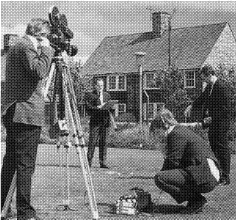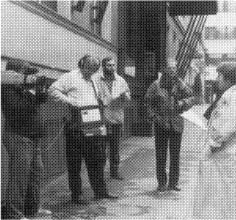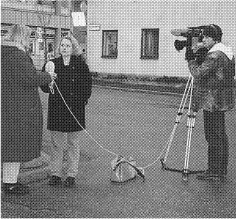Introducing the News Camera
The special demands news makes of camera crews working alongside television reporters include the ability to think and work quickly, physical stamina, an understanding of editorial values and a willingness to accept an uncomplicated–one would say–simplistic–approach to their art.
They should also be conscious of being in constant local, regional, network or international competition. Crews and reporters are judged each day by results, by the pictures–or the story behind the pictures–they did or did not get.
Staff versus freelance
The big international news services employ their own staff camera teams to cover the world. Those denied such luxury may have to share with other sections of their organisation, suffering delay and uncertain quality if news has a low priority. Other permutations include the hiring of freelance crews contracted by the day or by the assignment and the creation of scratch teams made up of spare production or technical staff. So although at the highest level those who operate the camera are trained specialists, it does not always follow that your technical assistant knows much more than you do about the best way to tackle a story.
Camera crew numbers
In contrast to the numbers making up teams generally engaged on feature or documentary work, camera crews for news have historically stayed at a minimum. At most they consist of up to three people, not counting the reporter or a producer. Cost is an obvious factor in keeping down crew size, but far more important is the need for teams to be able to travel light and work quickly under pressure, perhaps in conditions where greater numbers would be a dangerous hindrance.
Single crewing
Within the past few years advances in camera technology and the introduction of more flexible working arrangements have led to the widespread application of single crewing. News teams now invariably consist of a camera operator who is responsible for all aspects of raw material gathering–pictures, sound and lighting–and a reporter. Two-person crews (camera and sound specialists) exist only where employer-union agreements decree so, and in war or other dangerous circumstances which demand the presence of a second member of the technical team for safety and morale.
Video journalists
The reduction in crew numbers to the ultimate minimum–journalist, camera operator, sound recordist and lighting assistant combined–has already taken place. Some local cable TV companies in particular have found this way of operating economical and effective in the expensive world of orthodox news-gathering, training staff to shoot with lightweight cameras. The employers’ argument is that the system enables them to hire and deploy more camera people and therefore broaden the agenda than the conventionalists are able to do. Despite the counter-argument that standards (that word again) inevitably suffer, there is no doubt the economic factor guarantees the practice will grow.
The shrinking size of camera equipment
The 16 mm film camera was the versatile mainstay of television news programmes for more than twenty years in peace and war. Crews generally consisted of two people, one to operate the camera, the other the sound equipment. The magazine held a 400-foot roll of sound film, first mono then colour.

Electronic News Gathering. The ‘Lightweight Revolution’ of the mid-1970s introduced portable cameras with linked recorders using three-quarter-inch videotape housed in compact cassettes. Instant replay replaced film processing time, but in many news services camera teams continued to consist of two people.

Single Crewing. Compact, one-piece camcorders operated by a single person have added flexibility to news-gathering. The camera’s built-in microphone and lights allow the operator to work without a reporter if necessary. The next step, combining the roles of journalist, camera, sound and lighting assistant, has already been taken by some organisations which see it as economical and effective.

